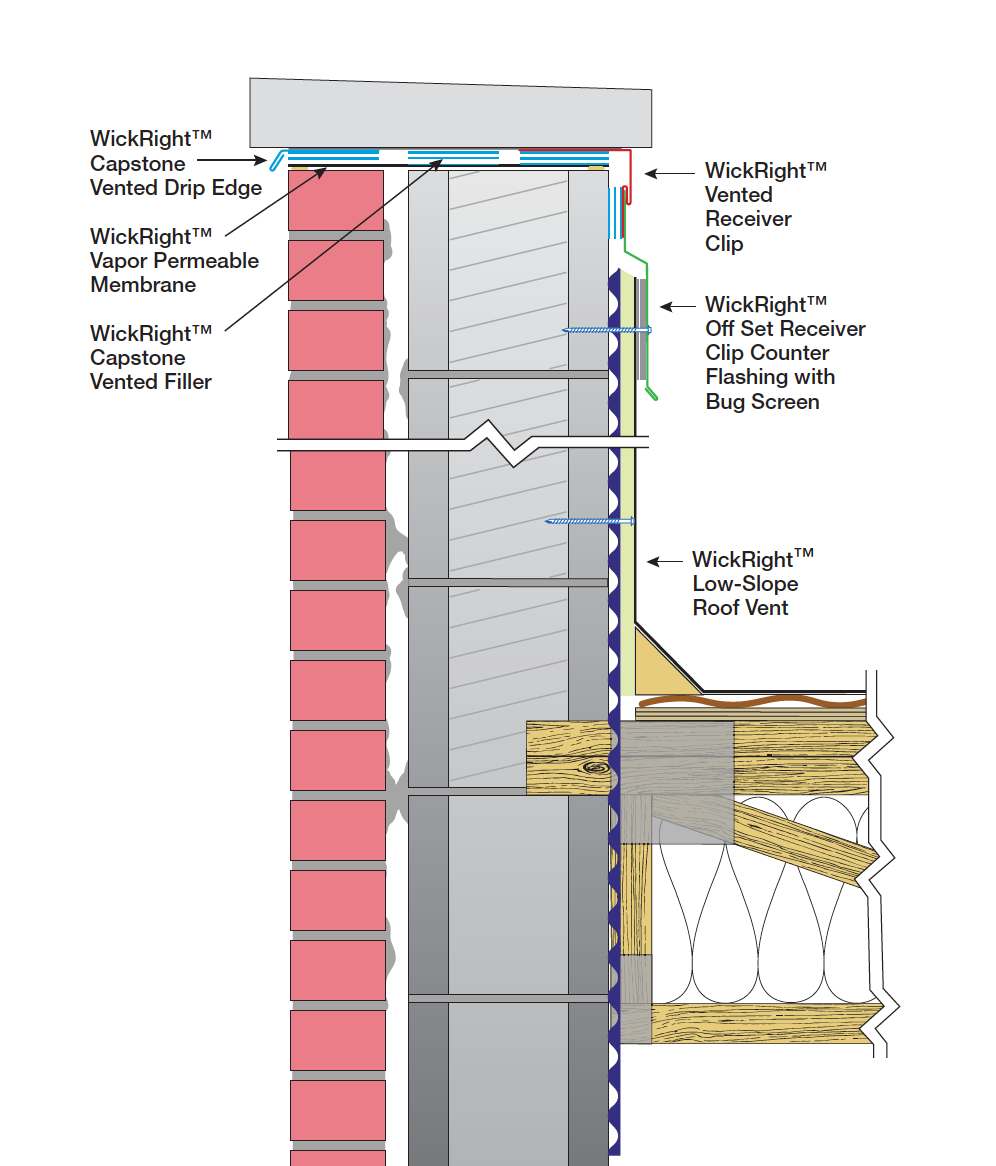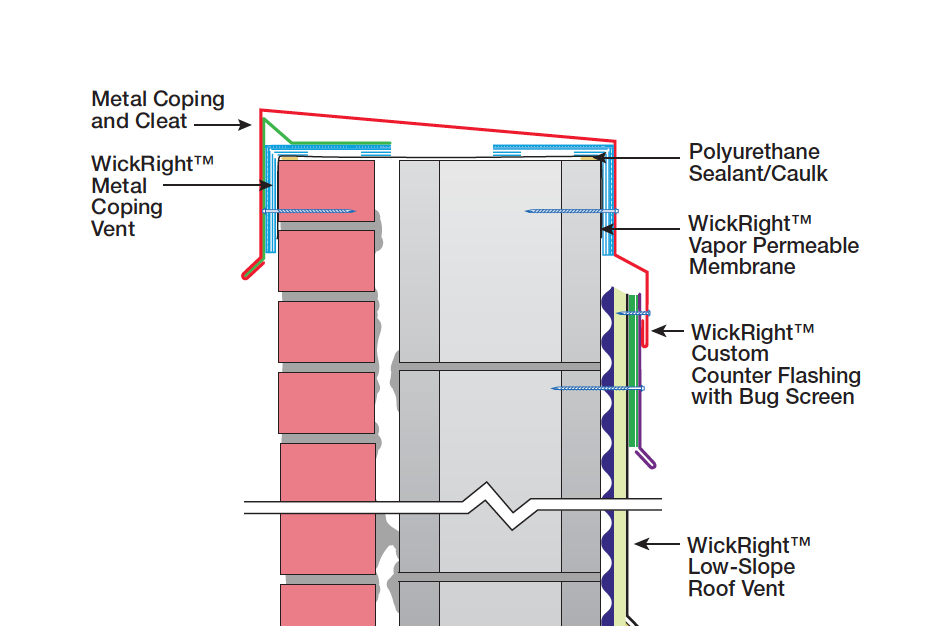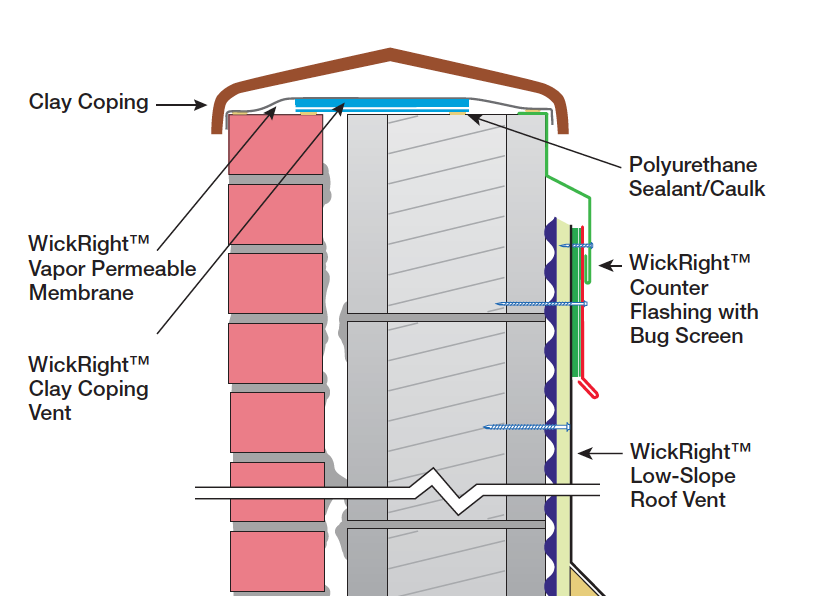Parapet Vents and Flat Roof Vent
The Keys to Repairing
Wet Split Face Block and Brick Buildings
How WickRight Parapet Vent and Flat Roof Vent Work

There is a WickRight Parapet Vent® for almost every building configuration. If you have unique situation, Bob Kelly will design a custom vent or repair for your building. These illustrations show the most commonly installed WickRight parapet vents and flat roof vents:
1. Patent-Pending
WickRight Vapor Permeable Membrane™ –
Our membrane is installed on top of the parapet wall under capstones. It allows moisture vapor to exit the wall and protects against moisture intrusion because water molecules are too large to pass through it.
2. Patented
WickRight Capstone Vented Drip Edge™ –
Our vented drip edge is installed on top of the Membrane, on the exterior side of the a parapet wall under a capstone. It protects the parapet wall from moisture intrusion and allows fresh air to pass over the top of the wall. Vented drip edge can also be installed on both sides of a parapet for aesthetic purposes.
3. Patent-Pending
WickRight Vented Receiver Clip™ –
Our vented receiver clip is installed on top of the Membrane on the interior side of the parapet wall. It is a combination Capstone Vented Drip Edge and built-in receiver clip for our Off Set Counter Flashing that protects the Flat Roof Vent.
4. Patented
WickRight Flat Roof Vent™ –
Our flat roof vent is installed vertically against the parapet wall at the junction of the parapet wall and the roof deck. It acts as a linear chimney, exhausting heat and moisture vapor from the roof system.
5.
WickRight Offset Counter Flashings and Bug Screen –
protects the Flat Roof Vent from moisture intrusion and the bug screen prevents insects from entering the building.

6. Patented
WickRight Metal Coping Vent™ –
Our metal coping vent is installed on top of the parapet wall under metal copings (and on some mansard roofs). It allows air flow over the top of the wall and moisture vapor release from the wall core.
Our metal coping profile is designed to protect a parapet wall from wind driven rain on both sides. The exterior leg of our metal coping profile is a 5" long. On the interior side of our metal coping profile is a built-in receiver clip to attach counter flashing.
When installed with WickRight Flat Roof Vent, the interior side of our metal coping profile protects the entire interior side of the parapet and acts as a roof termination.

7.
WickRight Clay Coping Vent™ –
Our clay coping vent is installed on top of the parapet wall UNDER our Vapor Permeable Membrane, under clay copings. It allows air flow over the top of the wall and moisture vapor release from the wall core. The Vapor Permeable Membrane protects the wall from any additional moisture intrusion or condensation build-up.
We have a unique installation technique for clay copings that prevents moisture intrusion between the clay bells. We also have a custom Counter Flashing Receiver Clip profile for use under Clay Copings when the WickRight Roof Vent is installed that protects the interior side of the parapet.
View WickRight Parapet Vent installations
Check out
WickRight Truss Reinforcement Brackets
Computational Fluid Dynamic Simulation –
WickRight Metal Coping Vent
Winter 30º F: Simulation video shows how a 14 mph wind enters the Coping Vent, the wind passes across the top of the wall and into the open block cores, then exits on the opposite side of the wall. This creates
6.4 cubic foot per minute (cfm) of fresh airflow per foot
of wall length, and
2.27 pounds of lift force (lbf) per foot
of wall length to draw moisture out of the wall.
Summer 80º F: Results indicate that when a 18 mph wind enters the Coping Vent, the wind passes across the top of the wall and into the open block cores, then exits on the opposite side of the wall, it creates
7.2 cubic foot per minute (cfm) of fresh airflow per foot of wall length, and
7.87 pounds of lift force (lbf) per foot
of wall length to draw moisture out of the wall.




